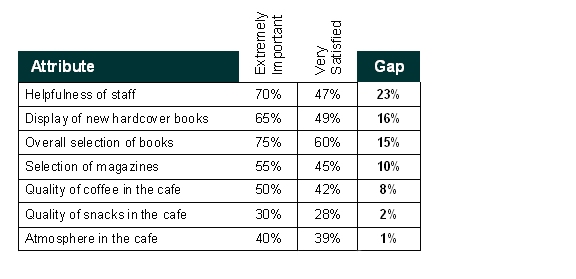Expertise in gap analysis and satisfaction measurement
Full Statistical Services • Enhance Satisfaction Measurement with Gap Analysis • Written Reports
What Is Gap Analysis?
The Gap Analysis process and Gap Analysis definitions can be illustrated with an example. In the table below, imagine that customers of a bookstore are asked to rate their satisfaction on the following "attributes" of the store:
In many customer satisfaction surveys, respondents are also asked to rate the importance of each attribute:
When both importance ratings and satisfaction ratings are collected in a survey, it is common to conduct Gap Analysis. The Gap Analysis process involves comparing how often each attribute is given a high satisfaction rating vs. how often the attribute is given a high importance rating.
For example, if the proportion giving a high importance rating for a particular attribute is much higher than the proportion giving a high satisfaction rating for that attribute, this would imply a large "Gap" between customer needs and perceived performance. Attributes with relatively large "Gaps" can be thought of as having more room for improvement and can be prioritized in future efforts to improve customer satisfaction.
Gap Analysis Definition
The Gap Analysis definition can differ depending on whether one wants to focus on "Top Box" or "Top 2 Box" results in the Gap Analysis process. By "Top Box" we mean the top rating level, which would be "Very Satisfied" in the first table above and "Extremely Important" in the second table. Then the "Top Box" Gap Analysis definition would be based on the difference in the proportion rating an attribute "Extremely Important" vs. the proportion "Very Satisfied" on the attribute.
By "Top 2 Box" we mean the top two rating levels (e.g., "Somewhat Satisfied" and "Very Satisfied" in the first table). Then the "Top 2 Box" Gap Analysis definition would be based on comparing the proportion rating an attribute at least "Important" vs. the proportion at least "Somewhat Satisfied" on the attribute.
A good Gap Analysis methodology includes both "Top Box" and "Top 2 Box" Gap Analysis. Of particular interest are attributes with both large "Top Box" and large "Top 2 Box" gaps. A large "Top 2 Box" gap is still worth considering even when the "Top Box" Gap is not large, but this attribute may be considered lower priority for improvement than an attribute with a large "Top Box" Gap.
After all, a large "Top Box" Gap indicates that the proportion "Very Satisfied" on an attribute is much lower than the proportion considering the attribute to be "Extremely Important." Intuitively, the more often customers consider an attribute to be extremely important, the more concerned a company would be about ensuring their customers are very satisfied on the attribute.
Gap Analysis Worksheet
To help clarify the Gap Analysis definition, the following Gap Analysis worksheet is based on "Top Box" results. The largest Gap is 23% for "Helpfulness of staff," as 47% were "Very Satisfied" on this attribute, while 70% considered it "Extremely Important." This relatively large Gap makes it clear that staff helpfulness has significant room for improvement.
The above Gap Analysis process is based on aggregate level findings. However, it is also possible to base Gap Analysis definitions on respondent-level analysis. That is, examine how often an individual respondent who rates an attribute "Extremely Important" is also "Very Satisfied" on that attribute.
More About Gap Analysis Methodology
You might have noticed differences in structure for the importance scale vs. the satisfaction scale above. The importance scale goes from extremely high importance to no importance, whereas the satisfaction scale goes from "Very Satisfied" to the polar opposite of "Very Dissatisfied." Moreover, the satisfaction scale is balanced, with two positive labels and two negative labels, whereas the importance scale has three levels indicating some degree of importance.
It is possible to use similar Gap Analysis definitions even if scale structure and labeling differ. The Gap Analysis process does not require exactly the same scales as shown above. We find that the importance scale above yields better discrimination than a more balanced importance scale. It is sometimes "too easy" for a consumer to say an attribute is important, and it helps to have respondents distinguish extremely important attributes. In the end, the value of Gap Analysis is based on the relative comparisons between attributes.
Please contact us if you would like to learn more about our gap analysis process.
- LEARN MORE ABOUT OUR SURVEY COMPANY.
Questions? Call Us at 1-877-225-7950
Our Gap Analysis Process
Amplitude Research has years of experience administering full-service mail, telephone, and online customer surveys. Our professional staff can provide a comprehensive solution using gap analysis methodology that includes hands-on involvement by one of our senior research professionals or statisticians. We can also incorporate a gap analysis worksheet into our reporting deliverables along with other analytics and additional key findings.
